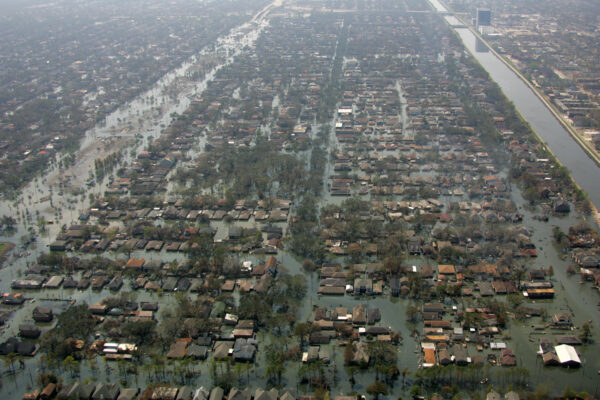One year before Hurricane Katrina, the Federal Emergency Management Agency (FEMA) and Louisiana’s Office of Homeland Security and Emergency Preparedness conducted a tabletop exercise that simulated a Category 3 hurricane hitting and flooding New Orleans. The exercise found that 100,000 people would be left without evacuation assistance.
The City of New Orleans, which was responsible for evacuating its residents, said that it would rely heavily on faith communities to organize and mobilize caravans for people without cars or in need of special assistance. New Orleans’ religious leaders, however, had concerns. They were fearful of their liability in the wake of such an event and said they could not assist in evacuation efforts without government resources.
Ultimately, New Orleans didn’t devise a plan.
As a result, when Hurricane Katrina hit Louisiana on August 29, 2005, tens of thousands of New Orleans’ most vulnerable residents — typically poor, African American and without cars or places to go — were left to fend for themselves, a tragedy that played out live on television across the globe.
Since welfare reform efforts in the 1990s took effect, there has been increasing emphasis placed on the importance of government partnering with congregations and faith-based organizations to address social needs, including disaster response. After 9/11, the federal government allocated hundreds of billions of dollars to state and local emergency management to increase government response capabilities. Yet, extraordinarily few funds have ever been made available to directly bolster or equip faith- and community-based agencies — assets government expects to utilize and that are essential to national resilience.
Katrina was a deadly wake-up call: Any emphasis or reliance upon partnerships without an actual plan saves no lives. The government’s necessary reliance on faith communities in crisis settings requires more than rhetoric; it mandates direct funding and practical support.
With the government and the American Red Cross overwhelmed by the scale and severity of Hurricane Katrina’s impact, it was the region’s congregations, faith-based organizations, nonprofits and civic groups that undertook a surprisingly large, varied and demanding set of relief and recovery activities — unplanned, but mostly with extraordinary effectiveness.
Faith communities’ roles in a disaster are an extension of their daily work. Whether it is managing food pantries, soup kitchen and clothing closets, or finding shelter, securing jobs or running large social service agencies, lay and ordained religious leaders are tasked daily with meeting the emotional, spiritual and social needs of people from every walk of life. They speak the language of every immigrant group, are literate in their religious needs and understand their skills and struggles. Most can “multiply loaves and fishes,” converting small donations and stretching their buying power to serve the many, often in ways the government cannot. The local social networks that they form make them essential to sustainable recovery and resilience.
There are always going to be spontaneous relief efforts, with congregations and other groups rising to meet their community’s needs. But the American people are best served when our government intentionally partners with faith communities before disasters to build networks capable of supporting readiness, response and recovery efforts. This requires emergency managers to be literate and competent in meeting the needs of America’s diverse and largely religious population.
The Department of Homeland Security Center for Faith-based & Neighborhood Partnerships, created by executive order in 2006, has helped improve government’s competence and collaboration with faith groups. Under President Obama, the Office of Faith-based and Neighborhood Partnerships’ mission focused more acutely on building resilience within diverse communities and engaging with faith communities on disaster readiness.
In 2011, FEMA adopted “whole community” doctrine, taking the rhetoric of partnership and creating a doctrine and a directive for greater action. Yet, we have a long way to go to fully implement it. The DHS center and other offices within FEMA stretch their limited resources to help local governments develop response networks, resources and capabilities. Even when faith communities are already at the emergency management table, however, the funding to support their efforts is scarce.
Katrina was a clarion call not yet fully answered. Every U.S. community should have a plan and the competency to engage congregations of all faith traditions, as well as faith- and community-based organizations, in responding to a disaster. Government agencies must commit staff and resources to build local operational partnerships with faith community stakeholders in order to build skills and expertise. These local networks and their individual members need access to emergency response training, government grants, philanthropic support and risk communication channels well before a disaster strikes.
Cities such as Houston, New York, Miami and Los Angeles have evolving partnerships with the other governmental agencies, including the Department of Homeland Security Center for Faith-based & Neighborhood Partnerships, and have been working to ensure that local congregations are coordinating and planning with pre-existing networks. Emergency managers and faith leaders there are meeting to train, map their assets and exercise their response plans. These models must be better resourced, sustained and replicated in all communities.
Perhaps the idea of having local congregations help with evacuation before a Category 3 hurricane in New Orleans was viable. When the hurricane came, though, the mechanisms were not in place to make this happen. Why aren’t they now — and not just in New Orleans, but across the nation?
The government alone cannot and should not be expected achieve all that needs to be done on its own; it will take a greater investment from all sectors of our society. Ignoring religious institutions, their networks and individual adherents is deadly. It jeopardizes the resilience of whole communities and places the majority of the American public at risk of being excluded from competent risk communication and partnerships. From the grassroots to Congress, this gap must be addressed.
Ten years after Katrina, government and faith communities must fully commit to building replicable, sustainable partnerships that will ensure another Katrina doesn’t happen.
Photo Credit: Bob McMillan / FEMA Photo 15440 via Kelly Garbato/Flickr
Brie Loskota is the former executive director (2016-2021) of the USC Center for Religion and Civil Culture.
Peter Gudaitis is the president of the National Disaster Interfaiths Network (NDIN) and a guest contributor with the USC Center for Religion and Civic Culture.




